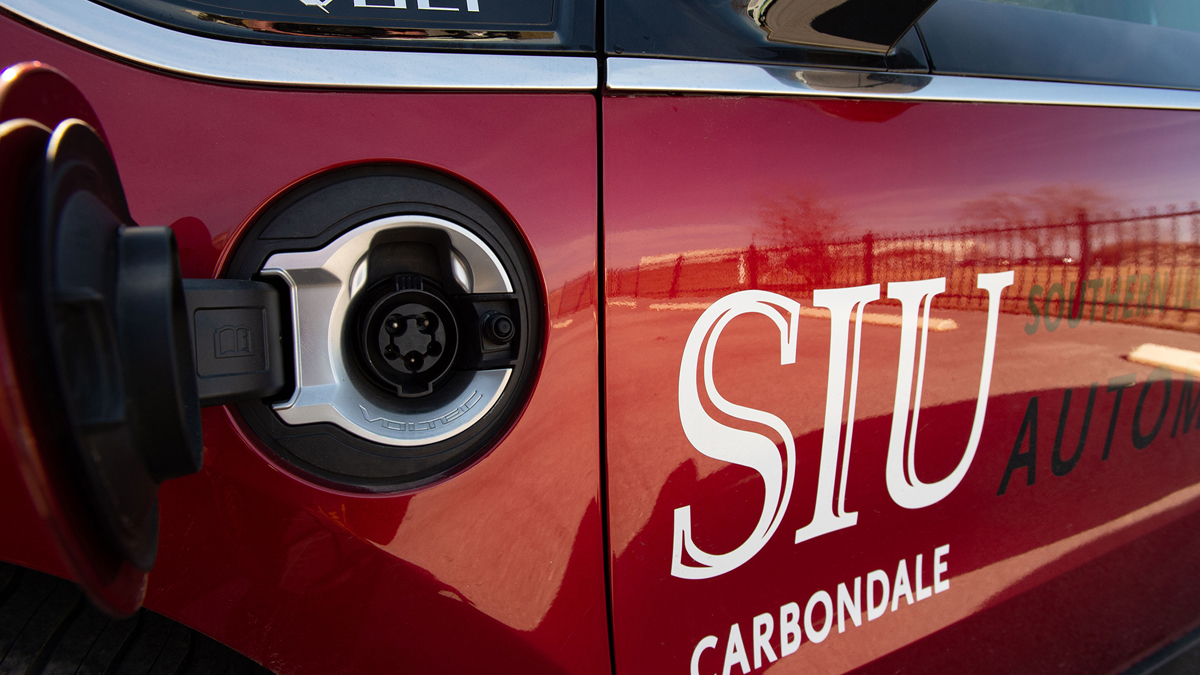
CHHS Automotive
May 13, 2022
SIU Automotive continues its 70-year history of setting the pace
Whether the work was in temporary military buildings or a state-of-the-industry facility, the strength of Southern Illinois University Carbondale’s nationally recognized automotive program continues to resonate through seven decades.
The School of Automotive is celebrating its 70th anniversary in 2022, and while the cars, trucks and various components have definitely changed during that time, the program’s foundation of its people — faculty, students and outstanding alumni support have not.
The program is planning a daylong alumni reunion on Sept. 24, during the university’s Family Weekend, at the Transportation Education Center that will include current students hosting a car meet.
For Neil Swartz, recently retired as a vice president for Toyota North America and current SIU Foundation Board member, coming to SIU Carbondale and learning about the opportunities of an automotive technology education was a game-changer. Swartz earned his applied science degree in automotive technology in 1976 and bachelor’s degree in automotive management in 1978. He initially saw a future as a “capable and fully certified technician.”
“My professors opened my eyes to a much bigger world and the ways I could leverage my automotive technology education in the broader automotive industry,” he said.
“What I found at SIU both surprised and challenged me, and it’s the secret sauce that has made the automotive program the envy of every other automotive school in the country — it is the SIU automotive faculty.
“From the beginning I could sense that these instructors were excited to share what they know with us. Even more fantastic was how hard they worked with the students to make each one of us feel their passion for automotive technology. They truly wanted us to understand, to learn and to grow — most of all they wanted each of us to be successful.”
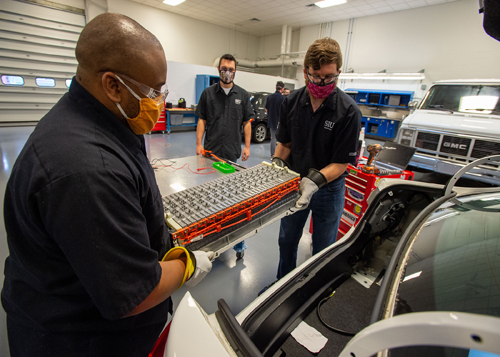 Student success, strong industry relationships and maintaining a deep family tradition among students and alumni remains critical, said Eugene Talley, the program’s interim director. No other program has the linkages to the automotive industry and partnerships that have been developed over time, said Talley, a 1993 graduate who returned to join the faculty in 2009.
Student success, strong industry relationships and maintaining a deep family tradition among students and alumni remains critical, said Eugene Talley, the program’s interim director. No other program has the linkages to the automotive industry and partnerships that have been developed over time, said Talley, a 1993 graduate who returned to join the faculty in 2009.
“The strong program is the result of our students being very successful and of leading this industry,” he said. “It’s all about our students and what they are doing and showcasing their talents so much that the companies find SIU is the place to come and recruit.”
Share a long history
Mike Behrmann, an automotive program graduate who retired in May after more than 33 years as a faculty member, including 12 as department chair, notes the first automotive-related courses on campus were held in 1938. SIU Automotive began as a degree program in 1952 with founding program director L.D. Willey as a part of the university’s then-Vocational Technical Institute, spending nearly six decades in buildings near Carterville.
In a competitive admissions program for more than 20 years, there are about 300 students for the spring 2022 semester and close to 3,000 alumni. With between 12 and 15 baccalaureate automotive programs in the United States, SIU Automotive remains one of the few university-related automotive programs in the nation, Behrmann said.
“We work very closely with our students, and our students get to know us,” he said. “We work hard to maintain that family and that relationship well beyond after they graduate from the program. We develop lifelong friendships with our students.”
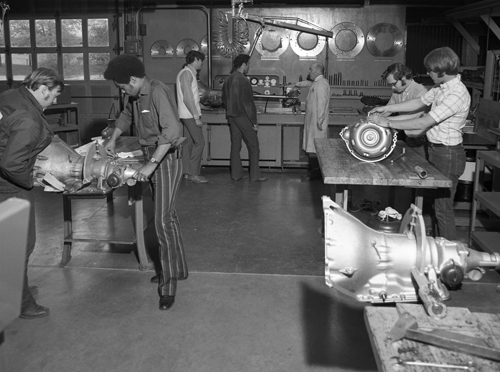 Talley, an associate professor, notes that alumni, faculty and staff sense the program’s legacy, consistency and desire to give back, with more than 10 faculty also being former students. The legacy of being only the fifth director in the program’s 70 years is “tremendous” and also a responsibility Talley doesn’t take lightly.
Talley, an associate professor, notes that alumni, faculty and staff sense the program’s legacy, consistency and desire to give back, with more than 10 faculty also being former students. The legacy of being only the fifth director in the program’s 70 years is “tremendous” and also a responsibility Talley doesn’t take lightly.
“What the other directors and chairs in the past have built, you don’t want to see that falter for a minute,” he said. “You don’t want to be the one of the five that doesn’t continue the traditions and successes we’ve had.”
Swartz said while he might not remember everything he studied at SIU, he won’t forget how the SIU Carbondale faculty and those in the automotive program made him feel.
“What I learned about automotive technology at SIU allowed me to understand the challenges facing technicians, dealers and manufacturers as they struggled to meet the expectations of customers in a complex and quickly evolving environment,” he said. “Throughout my career, I leaned heavily on my SIU-delivered knowledge of what goes on under the hood to make a difference in every position I held at Toyota Motor North America.”
Industry helps lead the program
The industry feedback SIU Automotive receives is invaluable. Talley notes that the program has “one of the largest and most active advisory panels of industry representatives to provide feedback and guidance of where we need to be.”
“We take their suggestions very seriously to maintain our program,” Talley said. “As the industry changes, so do we. As the industry is shifting to where we are going to see more electrification and electrical propulsion systems so you will see our curriculum and training shift and adjust.”
The program tries to maintain a fleet of about 130 vehicles, primarily provided by industry. But Talley notes that industry involvement doesn’t stop there. Countless components, tools, technical manuals, software, mentoring students and providing faculty with industry trends also tie into that industry support.
“There are many ways that these companies give that is critical for us to maintain the level of instruction that we have,” Talley said.
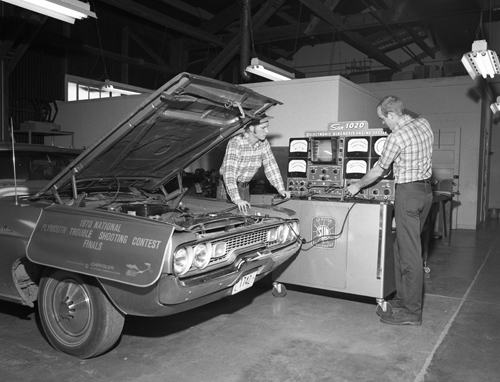 Graduates return to SIU and tell their stories to current students “and those experiences really help keep our students engaged and invigorated where they might end up,” he said.
Graduates return to SIU and tell their stories to current students “and those experiences really help keep our students engaged and invigorated where they might end up,” he said.
Swartz said he felt connected to the program even after he graduated. He participated in annual automotive advisory committee meetings to stay in touch with the faculty and to visit the campus once a year. There, he began to share his experiences with students and over time found ways to “forge a relationship” between Toyota and SIU.
“While much of this relationship was based on recruiting graduates, we also supported SIU with Toyota training materials, technical publications and donations,” Swartz said. “Hopefully this relationship will continue to grow in the years to come benefiting both SIU and Toyota. As an SIU graduate, it is incumbent upon each of us to find ways to give back to those who made us who we are today.”
High placement rates help recruitment
Talley and Behrmann emphasize that an important component is parents who ask what their child can do with an automotive technology degree. The program has about 90% placement before graduation, with many companies employing students while they are in school through internships and available jobs outside of class.
“That is the very first thing that I show the parents and the first thing I talk about when I meet with parents: what is the payoff for their child to come to this program?” Talley said. “That is the fact that our ties to industry offer so many opportunities. These are the opportunities if students come and do their part.”
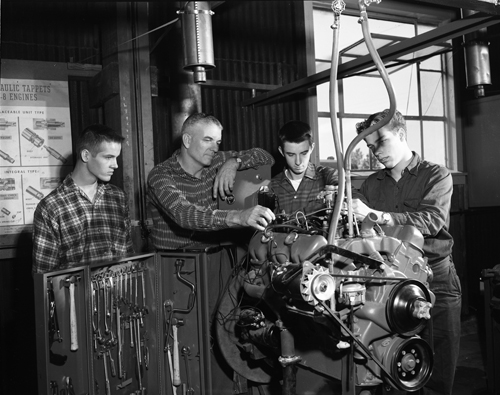 This year also marks the 10th anniversary of the opening of the Transportation Education Center for the automotive and aviation programs. Moving from dilapidated buildings in Carterville into a more efficient layout and facility that incorporates several services, demonstration and component laboratories, classrooms, fabrication lab and in-house auto parts store allowed the program to steadily grow.
This year also marks the 10th anniversary of the opening of the Transportation Education Center for the automotive and aviation programs. Moving from dilapidated buildings in Carterville into a more efficient layout and facility that incorporates several services, demonstration and component laboratories, classrooms, fabrication lab and in-house auto parts store allowed the program to steadily grow.
Photo 2 - Students remove a battery-pack from a 2012 Toyota Camry hybrid to diagnose. (Color photos by Russell Bailey, University Communications and Marketing. Black and white photos courtesy of Special Collections Research Center, Morris Library.)
Photo 3 - L.D. Willey, back right in lab coat, the automotive program’s first director, talks with two students while other students work on automatic transmissions in 1971.
Photo 4 - Students perform vehicle diagnostics during a class in 1971.
Photo 5 - Students work on a vehicle engine in 1960.
